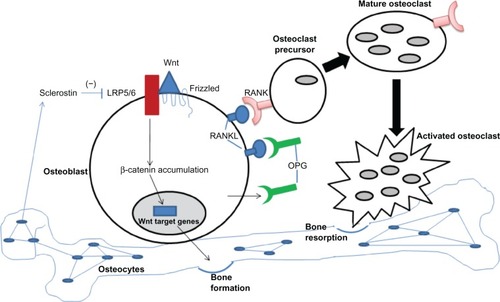Figures & data
Table 1 Diagnosis of osteoporosis
Table 2 Non-genetic risk factors for osteoporosis
Table 3 Loci associated with bone mineral density at the hip or spine at genome-wide levels of significance
Figure 1 RANK/RANKL/OPG pathway in bone remodeling. The balance between bone formation and resorption is largely regulated by the Wnt pathway (bone formation), the RANK (pink symbols)/RANKL (blue symbols) pathway (osteoclast activation), and sclerostin (negative regulation of bone formation). Osteoblasts express the cell surface receptors RANKL and Wnt and also secrete a soluble decoy receptor, OPG (green symbols). Wnt protein binds coreceptors Fizzle-Fz and LRP5/6, leading to stabilization of β-catenin and its translocation to the nucleus to regulate target genes, resulting in increased bone formation. In the absence of OPG, RANKL on the osteoblast surface is available to bind RANK present on osteoclast precursors. Binding of RANK/RANKL leads to osteoclast maturation and resorption of bone. Sclerostin, secreted by osteocytes, inhibits Wnt from binding LRP5.
